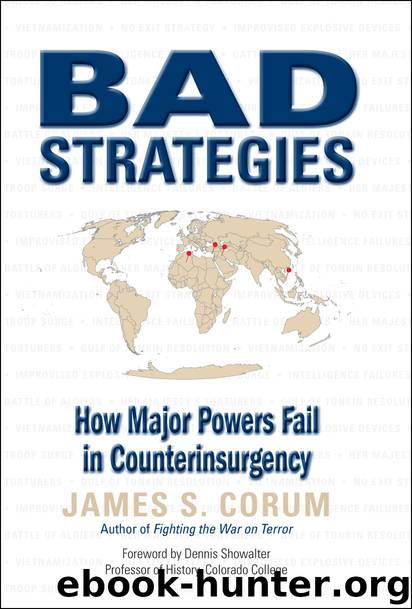Bad Strategies by James S. Corum

Author:James S. Corum
Language: eng
Format: epub
Publisher: MBI
Published: 2010-03-25T16:00:00+00:00
The Tet Offensive and a New U.S. Strategy
During late fall of 1967 the Viet Cong and North Vietnamese prepared for what would be a major blow to the South Vietnamese government, a plan to seize power in key cities and towns in Vietnam. This grand offensive was to be initiated January 30 during the Vietnamese New Year’s celebrations known as “Tet.” The initial attacks would be followed by a series of further attacks in the spring.49 The Viet Cong and North Vietnamese, also tired of the war, saw this as an opportunity to break the South Vietnamese. In many respects the Tet Offensive was a strategic mistake for the Viet Cong and NVA. The Viet Cong and North Vietnamese overestimated their support among the South Vietnamese population, believing that the offensive would initiate a mass uprising of the people. The communist forces also underestimated the fighting abilities of some of the South Vietnamese units, who performed much better in combat than the Viet Cong had expected. Finally, the communists underestimated the firepower of the U.S. forces and the Americans’ ability to react quickly.
In January 1968 the Viet Cong had seven divisions, numbering approximately 60,000 men, who were ready to assault key towns and provincial capitals. Forces were also ready to penetrate and seize portions of Saigon and the ancient imperial capital at Hue. The Viet Cong were backed by an estimated 400,000 paramilitary supporters. The NVA had an estimated 70,000 troops in Laos and South Vietnam. The Viet Cong had taken heavy losses between 1965 and 1967, so many of the Viet Cong main force battalions contained a high proportion of NVA soldiers.50 The communist forces faced more than 500,000 U.S. soldiers and marines and a South Vietnamese Army of 343,000. The Australians, Koreans, and Thais had a combined total of more than 48,000 men fighting in Vietnam in January 1968. Add to this the 70,000-man South Vietnamese National Police, 150,000 Regional Forces, 150,000 Popular Forces and a further 42,000 in civilian irregular defense groups. The combined allied forces totaled more than 1.2 million men.51 On paper, the Viet Cong task looked impossible, but the main blow would be struck against the South Vietnamese Army, a force that the communists believed to be a hollow shell. This assessment was largely correct. Many of the units of the South Vietnamese Army were in a poor state, with a lack of equipment and training.52
A large Viet Cong force had infiltrated into the suburbs of Saigon, taking over some approaches to the city. Another team fought its way onto the U.S. Embassy grounds. A large Viet Cong and NVA force fought their way into the old capital city of Hue, and raised the Viet Cong banner on the ancient citadel, one of Vietnam’s most famous national landmarks. The Viet Cong and NVA were always aware of the symbolic value of objectives such as the U.S. Embassy and Hue. In other parts of the country the Viet Cong were quickly repulsed by U.S. firepower and suffered massive losses.
Download
This site does not store any files on its server. We only index and link to content provided by other sites. Please contact the content providers to delete copyright contents if any and email us, we'll remove relevant links or contents immediately.
| Automotive | Engineering |
| Transportation |
Whiskies Galore by Ian Buxton(41718)
Introduction to Aircraft Design (Cambridge Aerospace Series) by John P. Fielding(33016)
Small Unmanned Fixed-wing Aircraft Design by Andrew J. Keane Andras Sobester James P. Scanlan & András Sóbester & James P. Scanlan(32684)
Craft Beer for the Homebrewer by Michael Agnew(18081)
Turbulence by E. J. Noyes(7893)
The Complete Stick Figure Physics Tutorials by Allen Sarah(7264)
Kaplan MCAT General Chemistry Review by Kaplan(6822)
The Thirst by Nesbo Jo(6758)
Bad Blood by John Carreyrou(6476)
Modelling of Convective Heat and Mass Transfer in Rotating Flows by Igor V. Shevchuk(6353)
Learning SQL by Alan Beaulieu(6158)
Weapons of Math Destruction by Cathy O'Neil(6084)
Man-made Catastrophes and Risk Information Concealment by Dmitry Chernov & Didier Sornette(5877)
Digital Minimalism by Cal Newport;(5586)
Life 3.0: Being Human in the Age of Artificial Intelligence by Tegmark Max(5403)
iGen by Jean M. Twenge(5321)
Secrets of Antigravity Propulsion: Tesla, UFOs, and Classified Aerospace Technology by Ph.D. Paul A. Laviolette(5237)
Design of Trajectory Optimization Approach for Space Maneuver Vehicle Skip Entry Problems by Runqi Chai & Al Savvaris & Antonios Tsourdos & Senchun Chai(4957)
Electronic Devices & Circuits by Jacob Millman & Christos C. Halkias(4864)
